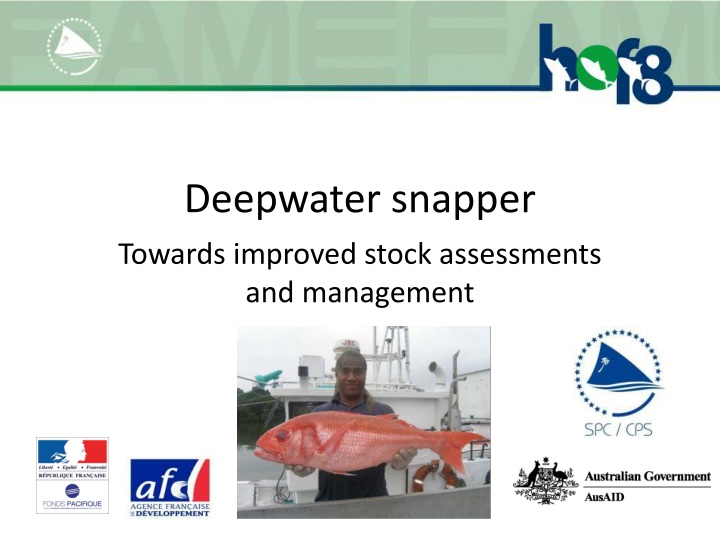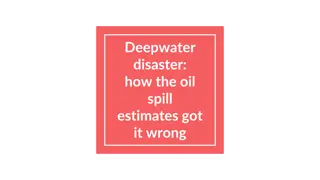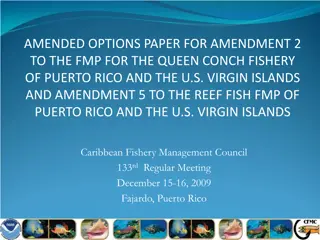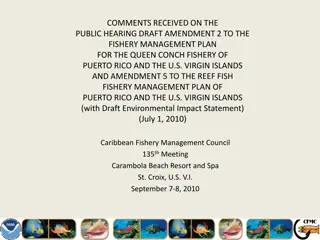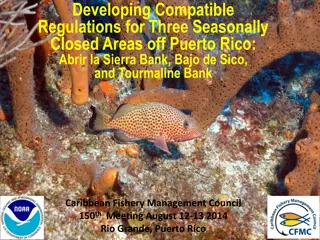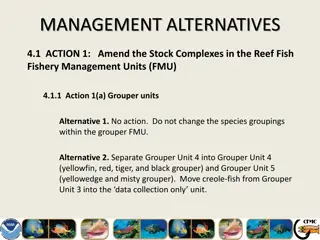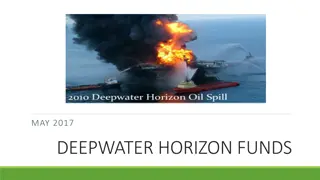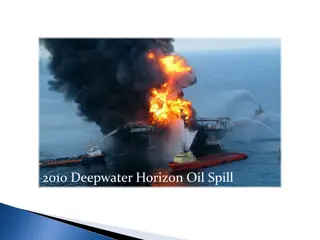Deepwater snapper
Deepwater snapper are vital fisheries resources in the Pacific region, with concerns over sustainability due to declines in catches. Efforts to improve stock assessments and management are underway, supported by funding from various organizations. Priority areas include fisheries data collection, biological knowledge enhancement, assessment and management strategies, and capacity development. A workshop held in 2011 set out a work plan focusing on key information and training needs. Standardizing fisheries data collection processes across the region is a key aim, facilitating better database management, data consistency, and cross-country comparisons.
Download Presentation

Please find below an Image/Link to download the presentation.
The content on the website is provided AS IS for your information and personal use only. It may not be sold, licensed, or shared on other websites without obtaining consent from the author.If you encounter any issues during the download, it is possible that the publisher has removed the file from their server.
You are allowed to download the files provided on this website for personal or commercial use, subject to the condition that they are used lawfully. All files are the property of their respective owners.
The content on the website is provided AS IS for your information and personal use only. It may not be sold, licensed, or shared on other websites without obtaining consent from the author.
E N D
Presentation Transcript
Deepwater snapper Towards improved stock assessments and management
Outline Background Work plan Progress to date Considerations
Background Deepwater snapper are an important fisheries resource in many PICTs Declines in catches in some PICTs have raised concerns about sustainability Quantitative assessments are limited by lack of adequate biological and fisheries data
Background At previous 3 HoF meetings, SPC members requested assistance with deepwater snapper management At 2011 HoF meeting, members endorsed SPC efforts to seek funding to support deepwater snapper project SPC obtained funding from: AusAID (2012-2015) - Vanuatu, Samoa, Tonga, and the Marshall Islands French Pacific Fund (2011-2013) - New Caledonia French Development Agency (2012-2013) - New Caledonia
Deepwater snapper workshop Deepwater snapper workshop held at SPC in July 2011 Identify priority information and training needs Participants from 12 PICTs The agreed outcomes from the workshop included a work plan for SPC s deepwater snapper activities
Work Plan There are 4 priority work areas: 1. Fisheries data collection 2. Improving biological knowledge 3. Fisheries assessment and management 4. Capacity development
Fisheries Data Collection Aim is to develop a standardised approach to fisheries data collection across the Pacific region many advantages: 1. Facilitates the development and maintenance of a common database system, which minimises development and maintenance costs; 2. Provides consistency in how and what data are collected and how they are analysed; and 3. Facilitates comparisons of fisheries among countries
Fisheries Data Collection Activities Support development of fisheries monitoring programs in-country (e.g. logsheets and port sampling) Utilise existing logsheets where feasible, to maintain familiarity in data reporting Otherwise utilise existing artisanal data forms Modify existing artisanal fisheries database (TUF-ART) to accommodate deepwater snapper fisheries data
Improving Biological Knowledge A large number of species are captured in deepwater fisheries Generally assumed that most species are long-lived, slow growing and late to mature Limited biological information available; longevity, growth and maturity is unknown for many species
Improving Biological Knowledge Activities 1. Fisheries independent surveys 2. Fisheries dependent collections (e.g. port sampling) Estimate longevity, growth rates, maturity schedules and spawning seasons for key species Examine genetic stock structure to identify management units
Fisheries assessment and management A lack of data has prevented traditional stock assessments for deepwater snapper A long time series of precise catch and effort data is required The cost of such data collection would most likely exceed the value of deepwater fisheries in most PICTs. Is it appropriate to allocate significant resources to support stock assessments for deepwater snapper?
Fisheries assessment and management Depletion experiments used to estimate Maximum Sustainable Yield (MSY) in 80/90 s MSY may not be most suitable reference point for deepwater snapper, because: 1. Estimates of MSY are usually very uncertain 2. MSY assumes that the environment does not vary 3. Fishing at MSY levels may produce undesirable effects for deepwater snapper fisheries e.g. while catches at MSY may be sustainable, catch rates may decline to levels that are not economically viable
Fisheries assessment and management Need to develop alternative management indicators and reference points for deepwater snapper Indicators need to be easy to monitor e.g. fish size Indicators and reference points need to be integrated into a formal management framework Management Procedures (MP) is a useful framework, and is used successfully in other deepwater fisheries MPs specify the management action(s) that will be taken when indicators reach certain threshold reference points E.g reduce effort by X% when average fish size is < Ycm
Fisheries assessment and management Activities Characterise deepwater snapper fisheries in each PICT to identify trends and critical data limitations Develop species distribution models and provide maps of potential habitat for the major target species Develop indicators and reference points suitable for application within a MP framework
Capacity development Aim to enhance capacity for deepwater snapper management and assessment in home country Opportunities for Pacific Island Fisheries Officers to complete post-graduate studies Long-term attachments to SPC to focus on developing skills in data analysis and assessment
Scientific Cruises Cruises in Fiji, Samoa, Wallis & Futuna, and Tonga Fished 24 seamounts
Scientific Cruises Detailed catch and effort data from lightly exploited populations - useful baseline information for assessments Biological samples collected from 970 individuals from 16 species
Data collection Supporting deepwater snapper fisheries data collection programs Tonga, Vanuatu, Samoa Implemented and supporting biological sampling Tonga, New Caledonia (>1000 samples)
Capacity development AusAID funding provides support for 4 Pacific Island Fisheries Officers to complete postgraduate degrees Scholarships Vanuatu Jeremie Kaltavara (MSc, Australian Maritime College) Samoa Ueta Fa asili Jr (MSc, University of Wollongong) Attachments, samples and analytical support Tonga Hau Halafihi (PhD, University of Canterbury) Tuvalu Etuati Poulasi (MSc, Australian Maritime College)
Species identification Collaboration with Genetics lab at University of Hawaii Identified new species (Etelis marshi) previously thought to be Etelis carbunclus (ruby snapper) Etelis carbunculus Etelis marshi Etelis marshi Etelis carbunculus Etelis carbunculus Etelis marshi
Identification cards Waterproof species identification cards for fishers Distributed to Fiji, Marshall Islands, New Caledonia, PNG, Samoa, Solomon Islands, Tonga, and Vanuatu
Considerations Heads of Fisheries are invited to: Note progress that has been made to date Note that SPC will be providing in-country support to establish fisheries data collection programs, but Acknowledge that success of the project will be dependent on support from Fisheries Departments Consider the need for funding beyond the life of this project (2015)
